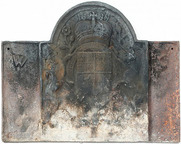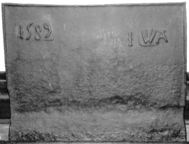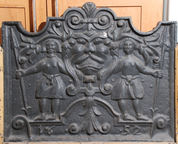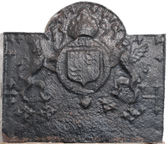-
1281
Description: Composite; arched rectangular shaped, armorial fireback, cavetto edging, with Stuart Royal arms, garter, supporters, crown and motto, and 1639 date above crown; this overlies a rectangular plate with fillet edging; top centre in the space each side of the central shield, an initial letter - W to left, C to right.
Notes: One of several variants using a fireback with the English Stuart royal arms, the date probably altered according to when it was cast. The original date of the fireback was probably 1619. Garth's Auctioneers, Columbus, OH, 3 Jan 2015, lot 2347 ($300).
Inscription: 1639 / W C
Arms: English Stuart royal
- Decoration tags:
- rectangular with round arch (shape)
- fillet (edging)
- carved stamps
- whole carved pattern
- composite
- extension panels
- heraldic
- armorial
- royal
- text
Manufactured: in 1639 possibly in the Forest of Dean area of England.
Current location: not known.
-
116
Description: Rectangular; twisted rope edging (top and sides); top left, date carved on block; top right, individual letter 'I' followed by 'WA' carved on block.
Notes: The same date stamp appears on a group of multi-facetted, arched firebacks bearing the crowned Tudor arms within a Garter. Formerly part of the Ade Collection (from Grove Hill, Hellingly, Sussex).
Inscription: 1589 I WA
- Decoration tags:
- rectangular (shape)
- rope (edging)
- carved stamps
- date stamp
- text
Manufactured: in 1589 in the Weald area of England.
Current location: Hastings Museum and Art Gallery, John's Place, Bohemia Road, Hastings, East Sussex, England.
Museum number: HASMG: 1952.51.42 (part of the Hastings Museum museum group)
- Attached to series:
- Date & initials firebacks
- 1589 series
-
171
Description: Quasi-rectangular with raised symmetrical scrolls between semi-circular re-entrants on top edge; ovolo-moulded edge on bottom and sides, with fillet edging on top; grotesque face with swirled hair locks, above an inverted floral spike, between two moustachioed male figures in tunics, holding pikes, standing on a cavetto-moulded compartment, date beneath.
Notes: Alleged to represent the 'Brede Ogre', Sir Goddard Oxenbridge (1478-1531) who, legend states, was sawn in half by local children. Stylistically similar to other firebacks with connections with Brede furnace.
Copies of this fireback are known.
Inscription: 16 52
- Decoration tags:
- rectangular with ornate arch (shape)
- fillet (edging)
- whole carved pattern
- individual numbers
- pictorial
- text
- humans
Manufactured: in 1652 probably at Brede Furnace in the Weald area of England.
Current location: Hastings Museum and Art Gallery, John's Place, Bohemia Road, Hastings, East Sussex, England.
Museum number: HASMG: 1924.42 (part of the Hastings Museum museum group)
Citation: Baines, J. M., 1958, Wealden Firebacks (Hastings Museum).
Citation: Butterfield, W. R., 10 Mar 1934, 'The Brede Ogre', Hastings and St Leonards Observer.
- Attached to series:
- Hooked '1' series
- Brede group
-
482
Description: Arched rectangular shape; rope edging (top and sides); Tudor royal shield, garter, crown and supporters (crowned lion and dragon); date split by crown; lower right, initial formed of twisted rope with fleur-de-lys terminals; small fleur-de-lys stamp repeated 14 times across top edge and arch; fleur-de-lys cross repeated six times across lower part of plate.
Notes: Identical arms can be seen on at least two other firebacks (no. 41 and no. 200); minor variations in the position of individual elements indicate that the garter and shield, crown, and each supporter were separately stamped. The lack of definition in the decoration suggests that this is a copy made from an earlier casting.
Inscription: 1595 / I H
Arms: Tudor royal - Elizabeth I
- Decoration tags:
- rectangular with round arch (shape)
- rope (edging)
- carved stamps
- armorial
- royal
- text
Manufactured: in 1595 possibly at Pounsley Furnace, Framfield in the Weald area of England.
Current location: in private hands, Maresfield, East Sussex, England.



